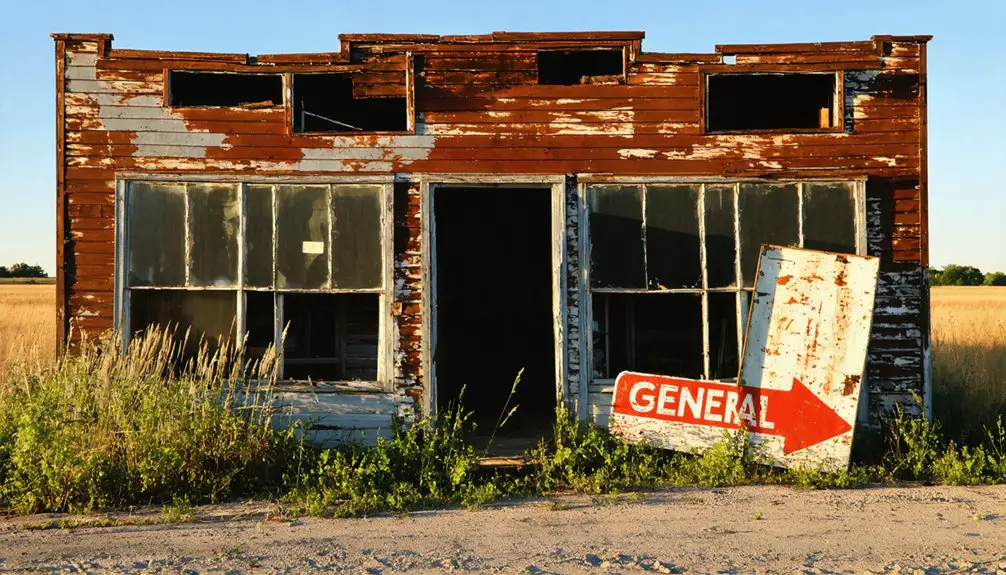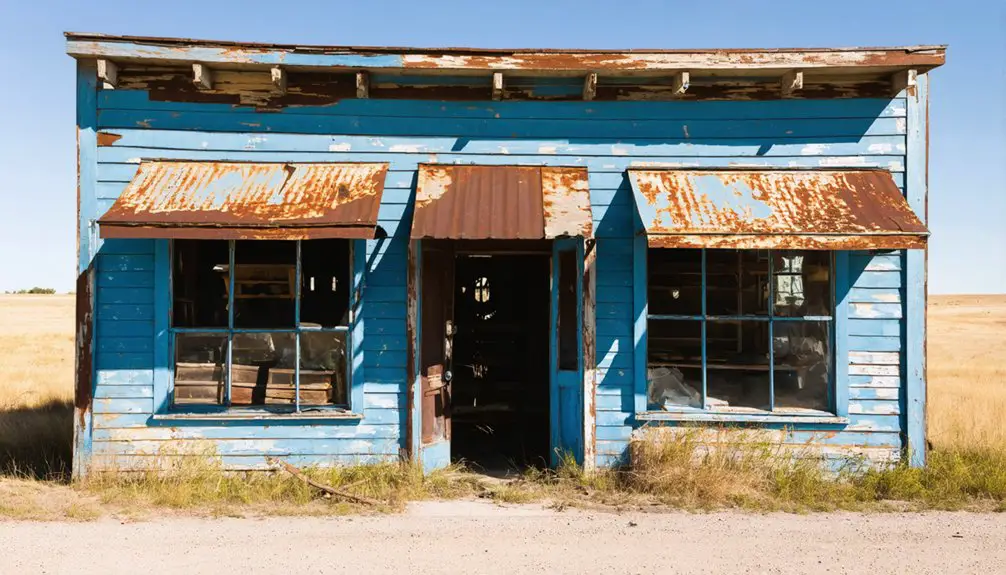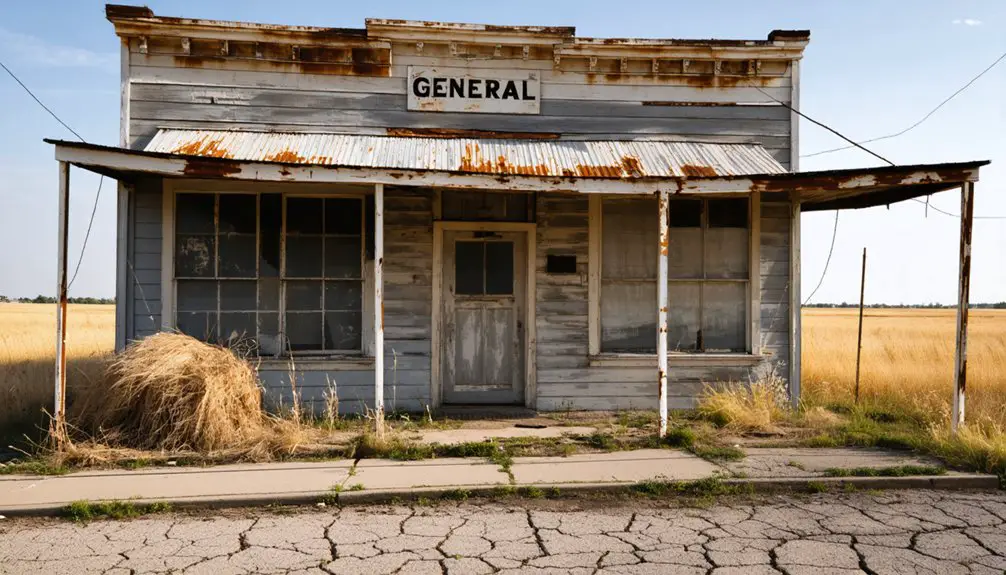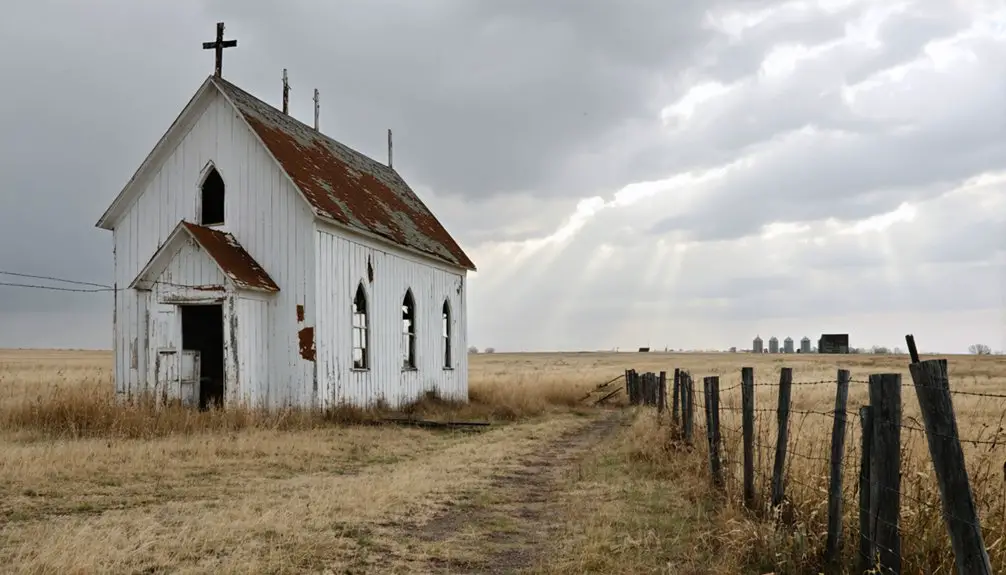You’ll find Provine’s ghostly remains along old Route 66 in Oklahoma, where it flourished as a essential waypoint in the early 1900s. The town’s decline began in the late 1940s after mining operations ceased and highway rerouting diverted traffic away. Today, you can explore architectural remnants like Hamons Station and the Hilltop Cafe, while local legends and paranormal tales add mystique to this abandoned community’s rich frontier heritage.
Key Takeaways
- Provine was an early 1900s agricultural settlement in Oklahoma that flourished during Route 66’s heyday before becoming a ghost town.
- The town experienced an 80% population decline in the 1940s due to mining depletion and changing transportation routes.
- Hamons Station/Lucille’s remains the best-preserved example of Route 66 architecture in Provine, recognized by the National Historic Registry.
- The town’s decline accelerated after the Great Depression, Dust Bowl, and World War II rationing impacted local agriculture and commerce.
- Jeff Provine’s ghost tours document the town’s paranormal activities, while preservation efforts focus on protecting remaining historical structures.
Historical Origins and Settlement
While many Oklahoma ghost towns emerged from short-lived oil booms, Provine’s story began as a modest agricultural settlement in the early 1900s.
You’ll find its roots deeply embedded in the settlement patterns of early farmers and ranchers who were drawn to the area’s fertile soil and reliable water sources. Unlike the rushed development of oil boomtowns, Provine’s community development followed a more organic path, growing steadily alongside significant trade routes. Like many of the state’s two thousand ghost towns, Provine faced challenges that would eventually lead to its decline.
As Oklahoma approached statehood in 1907, the town established itself as an essential agricultural hub where families built lasting connections. You can trace the town’s gradual formation through local oral histories, which paint a picture of determined settlers establishing churches, schools, and gathering places that became the heart of this tight-knit farming community. Similar to the dedication shown by Jeff Provine’s ghost tours, the early settlers were passionate about documenting and preserving their community’s stories.
Life Along Route 66
The roar of engines and gleam of chrome along Route 66 transformed Provine into a bustling waypoint during the highway’s golden age.
You’d find travelers pulling into the local service station, their vehicles kicking up dust as they sought fuel and repairs. The neon signs of motels and diners beckoned weary drivers, promising hot meals and comfortable beds.
Life revolved around serving these passing motorists – you couldn’t miss the steady stream of customers flowing through local businesses day and night. Just like towns such as Texola that saw its population plummet to 36 residents after being bypassed, Provine’s fate was sealed.
The town’s beloved Tumbleweed Grill, which was once the oldest-running cafe on Route 66, shut its doors during the pandemic.
When the highway got rerouted, though, everything changed. The town tried building new services closer to the revised route, but it wasn’t enough.
Those bright neon signs gradually dimmed, and the once-busy establishments fell silent, leaving only sun-bleached signs and empty buildings as evidence of Provine’s Route 66 heyday.
Decline and Abandonment
You’d recognize Provine’s decline starting in the late 1940s, when the depletion of local mining resources triggered a mass exodus that saw the population plummet by over 80% within a decade.
Much like the experience of other mining communities found in place name disambiguation entries, the town’s gradual disappearance was inevitable.
The town’s isolation from newly built highways dealt another devastating blow, as businesses shuttered and essential services gradually disappeared from the community. Like many towns affected by economic booms and busts, Provine’s fate was sealed by its dependence on a single industry.
Without a sustainable economic base, Provine’s remaining infrastructure fell into disrepair, with most buildings eventually collapsing or being demolished by the 1970s.
Population Loss Over Time
Since its early days as a bustling community, Provine’s population decline followed a pattern familiar to many Oklahoma ghost towns, marked by infrastructure changes and economic shifts that gradually emptied the town.
You’ll find Provine’s demographic shifts mirror those of Oklahoma’s estimated 2,000 ghost towns, where population statistics often show losses of up to 80% from peak levels. The loss of essential gypsum mining operations severely impacted the town’s economy, similar to what happened in Acme and Bickford. Like the noble Cardin family of England who traced their lineage through Portugal, many of Provine’s founding families scattered to different regions.
Like many rural communities, Provine’s decline accelerated when essential services began closing their doors. The pattern you’d recognize from Route 66 towns repeated here – businesses shuttered one by one, leading to a domino effect of departures.
As neighboring communities grew and infrastructure bypassed the town, Provine’s remaining residents faced the tough choice between staying in their dwindling community or seeking opportunities elsewhere.
Economic Factors Behind Exodus
While many ghost towns fade due to a single cause, Provine’s economic decline stemmed from multiple devastating blows that struck in rapid succession during the early-to-mid 20th century.
Today, ghost tour guides preserve the eerie history of Oklahoma’s abandoned towns like Provine through engaging storytelling and historical context.
You’ll find the town’s tragic economic story mirrors many Oklahoma communities that couldn’t recover from these combined challenges:
- Agricultural decline hit first as the Great Depression crushed crop prices, followed by the devastating Dust Bowl that turned fertile fields into wasteland.
- Transportation changes redirected traffic away from local businesses that depended on Route 66 travelers. The construction of Interstate 40 in 1971 proved especially devastating to local commerce.
- World War II’s rationing strangled remaining commerce as fuel and tire shortages kept vehicles off the roads.
- The region’s mining operations eventually dried up, eliminating vital jobs and triggering mass exodus as families sought opportunities elsewhere.
The town simply couldn’t overcome this perfect storm of economic catastrophes.
Infrastructure Deterioration Patterns
As abandonment took hold of Provine in the mid-20th century, the town’s infrastructure began a predictable pattern of decay that’s common across Oklahoma ghost towns.
You’ll notice how quickly utility shutdowns accelerated the town’s decline – water wells dried up, power lines came down, and communication systems ceased to function.
The infrastructure decay hit hardest at the town’s core, where you can still see the skeletal remains of schools and churches succumbing to nature’s relentless assault.
Weather damage, vegetation overgrowth, and pest infestations have transformed once-sturdy structures into dangerous shells.
Roads that once connected Provine to crucial transportation routes now end abruptly in weed-choked pavement, while former rail lines lie silent, their ties and tracks long since salvaged for scrap.
Notable Landmarks and Architecture

Through decades of transformation, Provine’s architectural legacy centers around its historic Route 66 structures, with Hamons Station standing as the town’s crown jewel.
Now operating as Lucille’s, this architectural significance captures the essence of mid-century roadside design that earned Provine its place on the National Historic Registry in 1997.
You’ll find these defining roadside relics throughout town:
- Hamons Station/Lucille’s – the best-preserved example of Route 66 commercial architecture
- Hamons Court motel – showcasing classic mid-century traveler accommodations
- Hilltop Cafe building – though deteriorating, remains a tribute to highway dining culture
- Former Kirk’s Texaco site – where I-40 construction claimed a piece of history
These structures tell the story of a once-bustling community where travelers, locals, and even farm animals created a unique small-town atmosphere.
Local Legends and Supernatural Tales
Beyond the historic buildings and roadside architecture, Provine harbors a rich tapestry of supernatural tales and local legends that have captivated residents for generations.
You’ll hear whispers of Rip Rowser Bill, whose haunting tale marks Oklahoma City’s first recorded death and the establishment of Bricktown’s original cemetery. The area’s ghostly encounters continue to intrigue locals, particularly around the old Starbucks location where mysterious occurrences are commonplace.
Our folklore traditions are kept alive through Jeff Provine’s ghost tours, which have documented countless paranormal activities since 2009.
From the exorcised boarding house on Elm Ave to the spirits who playfully mislead mediums, each story weaves historical fact with supernatural mystery.
These tales aren’t just entertainment – they’re threads in the fabric of our community’s identity, connecting us to our pioneer past.
Cultural Impact and Heritage

While many Oklahoma ghost towns fade into obscurity, Provine stands as a powerful symbol of our state’s frontier heritage and cultural identity.
This remarkable site’s cultural legacy continues to shape our community memory through local festivals, educational programs, and heritage tourism.
You’ll discover Provine’s lasting impact through these key elements:
- Active preservation efforts that connect you to the authentic pioneer experience and everyday lives of early Oklahomans
- Educational initiatives that bring frontier history alive through hands-on learning and archaeological exploration
- Regional celebrations that strengthen your connection to Oklahoma’s rugged past
- Heritage tourism opportunities that let you experience the mysterious allure of our frontier landscape
Provine’s influence extends beyond its physical remains, enriching our understanding of Oklahoma’s settlement history and fostering pride in our shared cultural heritage.
Preservation Challenges and Efforts
Preserving Provine’s rich cultural heritage faces mounting challenges that demand immediate attention from our community. The historic structures are deteriorating rapidly due to Oklahoma’s harsh weather, with walls and roofs at risk of collapse. Limited funding sources and complex legal hurdles make thorough restoration increasingly difficult.
You’ll find that community involvement remains vital to Provine’s survival. While local historical societies and preservation groups work tirelessly to document and protect these sites, they’re often hampered by insufficient resources.
The town’s remote location and environmental threats, including soil erosion and agricultural encroachment, further complicate preservation efforts. Despite these obstacles, dedicated volunteers continue restoration projects where possible, though they’re racing against time.
It’s critical to secure additional funding and technical support to prevent losing these irreplaceable pieces of our history.
Photographic Journey Through Time

You’ll find a rich photographic legacy of Provine’s historic structures, from weathered storefronts to the old church steeple that still pierces the prairie sky.
While many original buildings have succumbed to time, archived photographs preserve memories of the town’s bustling main street, complete with its wooden boardwalks and hitching posts.
Today’s photographers continue documenting the remaining architectural features, creating a visual bridge between Provine’s past glory and its present state as a ghost town.
Historic Structures Still Standing
Today’s visitors to Provine can explore a haunting collection of weathered structures that tell the story of this once-thriving Oklahoma town.
You’ll find architectural significance in the simple wood-frame buildings that remain, complete with rusty metal roofs and weathered brick chimneys that speak to our pioneer heritage.
What you’ll discover in Provine’s remaining structures:
- An old general store with faded signage, showcasing early commercial architecture
- Historic homes featuring classic early 20th-century construction methods
- Original stone foundations marking where buildings once proudly stood
- Surviving brick chimneys that rise above partial walls and empty lots
Despite harsh weather and vandalism taking their toll, these structures still offer opportunities for community engagement through ghost town tours and historical education, preserving our connection to Oklahoma’s settler past.
Documenting Architectural Heritage Today
Through innovative photographic techniques, our community has initiated a thorough digital preservation project to document Provine’s architectural legacy.
You’ll find high-resolution images capturing every weathered brick and timber, while drone photography reveals the town’s layout from perspectives we’ve never seen before.
Our heritage photography efforts include detailed 3D models of remaining structures, created through photogrammetry.
We’re using time-lapse cameras to track seasonal changes, and you can access our growing digital archive through the local historical society’s website.
The architectural documentation process hasn’t been easy – we’ve faced challenges with unstable structures and difficult lighting conditions – but we’re preserving these irreplaceable pieces of history.
Our team of volunteers continues to expand this visual record, ensuring Provine’s story endures for future generations.
Lost Buildings Through Images
A remarkable collection of historical photographs provides our only window into Provine’s vanished architectural landscape.
Through visual storytelling, you’ll discover how our once-thriving town transformed from bustling streets to silent ruins. These images reveal lost architecture that defined our community’s character – from wooden storefronts to simple gabled homes.
Take a journey through time with these striking photographic revelations:
- Main street’s general stores with their iconic false fronts
- The progression of building deterioration over decades
- Evidence of flooding that contributed to the town’s abandonment
- Nature’s gradual reclamation of human-built structures
You can trace Provine’s story through these precious visual records, which now serve as vital tools for preserving our town’s legacy in Oklahoma’s rich history.
Frequently Asked Questions
What Is the Current Population Count of Provine as of 2023?
Based on current demographics and population trends, you’ll find zero permanent residents in Provine as of 2023, reflecting your area’s complete shift from populated community to documented ghost town status.
Are There Any Annual Events or Festivals Still Held in Provine?
Like footprints in forgotten sand, you won’t find any ghost town events or local traditions still happening in this deserted place – time has erased all annual gatherings from its empty streets.
Can Visitors Legally Explore Abandoned Buildings in Provine?
You can’t legally engage in urban exploration of Provine’s abandoned buildings without explicit owner permission. Legal restrictions protect private property, and you’ll risk trespassing charges if you enter without authorization.
What Was the Peak Historical Population of Provine?
You won’t find official peak population records, but given Provine’s limited historical significance and eventual population decline, it’s estimated the settlement never exceeded a few hundred residents at most.
Does Anyone Maintain Genealogical Records of Former Provine Residents?
You’ll find genealogy resources through Custer County Clerk’s Office, Oklahoma Historical Society, and FamilySearch’s historical archives, though you’ll need to search broadly since Provine-specific records are scattered.
References
- https://thelostogle.com/2019/10/24/ghost-lahoma-city-touring-haunted-bricktown-with-jeff-provine
- http://www.ou.edu/news/articles/2024/may/ou-researcher-unveils-book-of-oklahomas-ghost-towns.html
- https://www.youtube.com/watch?v=5NI-cU4nQ6w
- http://www.jeffprovine.com
- https://www.onlyinyourstate.com/experiences/oklahoma/historic-gas-station-ok
- https://en.wikipedia.org/wiki/List_of_ghost_towns_in_Oklahoma
- https://okmag.com/blog/a-ghostly-site/
- https://www.okhistory.org/publications/enc/entry?entry=GH002
- https://www.routemagazine.us/stories/loneliest-places-along-route-66
- https://www.islands.com/1870004/oklahoma-town-route-66-almost-abandoned-curious-historical-sites/



